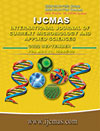


 National Academy of Agricultural Sciences (NAAS)
National Academy of Agricultural Sciences (NAAS)

|
PRINT ISSN : 2319-7692
Online ISSN : 2319-7706 Issues : 12 per year Publisher : Excellent Publishers Email : editorijcmas@gmail.com / submit@ijcmas.com Editor-in-chief: Dr.M.Prakash Index Copernicus ICV 2018: 95.39 NAAS RATING 2020: 5.38 |
Canine pyoderma is one of the most common causes of dermatitis with worldwide occurrence in small animal practice. The condition is diagnosed on the basis of clinical manifestations, isolation and identification of causative organisms by bacteriological cultural examination. A study on 150 clinical cases of Canine pyoderma was conducted at Belgachia Veterinary Clinics, under the Department of Veterinary Clinical Complex, Faculty of Veterinary and Animal Sciences, West Bengal University of Animal and Fishery Sciences, Kolkata during the period from May 2018 to April 2019. In the study undertaken, bacteriological culture examination of 30 pus swabs resulted for bacterial isolates. Exudates/pus samples were collected and subjected to bacteriological cultural isolation, identification and subsequently antibiotic sensitivity testing. Out of 30 isolates, 24 isolates were gram positive Cocci i.e. Staphylococcus sp. and 6 isolates were positive for gram positive Staphylococcus and Streptococcus mixed infection. Out of 24 Staphylococcus isolates, 24 were sensitive to CIS, 22 to CIT and AMS, 21 to NIT, 18 to AK, 13 to CIP, 12 to AX, 9 to CTR, 7 to CXM, 7 to CZX and 2 were sensitive to AMC. Out of 6 mixed infections of Staphylococcus sp. and Streptococcus sp., 4 were sensitive to NIT, CIS, AK and AMS, 3 to CZX, 2 were sensitive to AX, CTR, CXM, CIT, CIP, AMC, and AZM. Thirty numbers of positive pyoderma cases were treated with different drugs which are Enrofloxacin, Miconazole Nitrate, Chlorhexidine Gluconate, Cephalexin, 50% Ceramides, 25% Cholesterol. Treatment continued for a period of minimum three days post clinical recovery.
 |
 |
 |
 |
 |